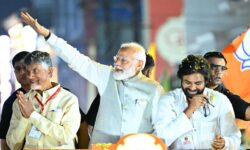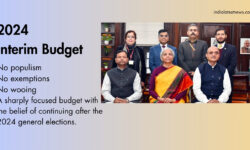AN ECONOMIC HISTORY OF MODISM
Either in central politics or not, Modi was always the subject of discussion after 2000. He is known for his speeches, but his works speak louder than that. When he was in Gujrat, state had to face some natural disasters and one could not imagine that Gujarat would stand once again. After these disasters and troubles in 2002, Modi had to face flak from the opposition and pressure was building on Modi to quit. However, after winning the election of 2002, Modi’s vision was shifted to economic development of Gujrat. He launched the programme of vibrant Gujrat. He attended meetings with business persons and started to rebuild the development process of Gujrat. And the result – we all have witnessed. The Gujarat Model was in itself an election agenda for the BJP and we just cannot deny it that Gujarat has indeed developed!
Coming to the national politics, he was elected the prime minister of India in 2014. His indication towards shaping the Indian economy and push it towards a path forward can be easily seen from the first month since he assumed office. Here is list of the key achievements of Narendra Modi in the terms of the country’s economic growth:
- Jan-Dhan Yojana: The announcement of this yojana was made on the 15th of August 2014, and it was launched by prime minister of India on 28th august 2014. This is regarded one of the greatest work in the field of financial inclusion in the history of India. And not only India, the plan has been appreciated across the globe because of its execution on a wide scale. A country where half of its population did not have the facility of bank account, one can easily imagine what was happening in the name of development and ‘garibi hatao’ yojanas! Some economists also argued that India was on the path of development and this can make anyone annoyed who understands a little bit of economics. Now, about the yojana, executed by financial services and undertaken by the ministry of finance, on the inauguration day, 1.5 crore bank accounts were opened under this scheme. Guinness World Records recognised the achievements made under PMJDY. By 1 June 2016, 22 crore accounts were opened under this scheme and ₹ 384.11 billion were deposited in those accounts. Thus, on two visible fronts, this policy was a huge success – in the terms of the numbers of accounts opened and also in the terms of the money deposited in the banks. This was considered, and actually was, for the people who could open their accounts without a single rupee. However, the deposits were remarkable and it shows how eager the people without a single bank account in the family were to come under the benefits of banking services.
- Make in India: It is one of the greatest initiatives taken by the Indian government to facilitate investment in India. It was launched by PM Modi on 25th September 2014. The major objective is making India the greatest destination for the production and investment. The results of this initiative are favourable for the Indian government. In 2015, India was the top destination globally for foreign direct investment, surpassing the United States of America as well as China. India received a total of US$ 63 billion in FDI. Responses are also favourable for India as Spice, Samsung, Xiaomi, Hitachi, Huawei, and many IT giants established their new production units in the different states of India. Anyone with a basic knowledge of economics’ straight line rule can easily understand that new units will bring not only prosperity to India but also jobs for Indians! Thus, despite the Babbar Sher hallucination of Rahul Gandhi, India is aggressively moving towards a path of development in the production sector and we will surely do something big in the near future.
- Coal Block Auction: One of the black patches on the Congress regime was the auction of coal block. They robbed in daylight and looted our country. One of biggest scam in the Indian history was executed, and sadly botched, by the Congress government under the honest nose of Man Mohan Singh, the two times unfortunate prime minister of India. Modi government successfully did this auction two times without creating any buzz at all.
- Cooking Gas subsidy: The Rule of subsidies is simple – take taxes from rich and distribute it among poor in welfare projects. Unfortunately, rich are enjoying these schemes rather than the poor. Specially, sticking to the cooking gas, more than half of the Indian population do not have this facility. To strike down these types of long coming corrupt schemes, one needs a hard step. First, Modi government opened bank accounts of poor people under jan dhan yojana and then started giving subsidies directly to their bank accounts. Now, there is no chance for the middleman to do any illegal activity. In the beginning, government asked people to give up their subsidy voluntarily who could afford it. Now, there is no any provision for gas subsidy for the person earning more than 10 lakhs per annum. By this scheme, government has saved more than 35,000 crores. This money, in turn, are spent for poor families to give gas connections to them entirely free of cost. Such a mass movement in the cooking gas history in India was never to be seen despite so many rants of taking the welfare to the end user in the poor Dalit houses where the Congress VP, Rahul Gandhi spends nights and enjoys food time to time. I have seen the officials screaming to the top of their throat in the villages with the help of mics and vehicles and urging the poor to bring gas connection home. Do you see this scheme working? Well, I see.
- Rural Electrification: The marrow point in the accumulating agenda of the government is welfare of the poor. These types of steps show a strong determination about completing the tasks what have been promised. Government made a promise to the poor villages that they will provide electricity to 18,452 villages in 1,000 days. These villages have not seen a yellow burning bulb in their life time. According to the data provided and verified officially, 11,478 villages have already been electrified as of now. I have spent almost 18 years of my life at a place called Parwalpur. I remember very well that the person called Nandan Gop who used to deliver milk to our family early in the morning, lived at Nehua Par (officially Nehusa), a rural or rather remote village which has not seen electricity since the independence. It is only sarcasm and nothing else when Sonia Gandhi talks of development and policies of the Congress in her rallies! Thanks to NaMo that Nandan has also the opportunity to see the electric bulb hanging with the help of a nail in his house built with the soil of ‘undeveloped and undelivered’ Indira Awas yojana! This type of real incident shows commitment to the poor and about their grieves.
- Skill India: This is one of the greatest schemes launched by Indian government on 16th July 2015 by the prime minister of India, Narendra Modi. The aim of this campaign is to train 400 million youths in the whole country, to meet the needed qualities to get a job or run their own business. Moreover, responses are great that government has receiving from around the globe. On 12 February 2016, Oracle announced that it will build a new 2.8 million square ft. campus in Bengaluru, which will be the largest branch outside of its headquarters in redwood Shore, California. Oracle academy will launch an initiative to train more than half a million students each year to develop computer skills by expanding its partnership to 2,700 institutions in India from 1,700 at present. The major nature of Indian unemployment is cyclical and frictional. Cyclical unemployment is due to economic fluctuations but frictional unemployment is due to us. Recent survey shown by Zee News, more than 70% of our graduates cannot prove their educational qualification when the situation demands so. So, a new introduction of new technology can create a mass unemployment in India. However, if this programme achieves its targets in upcoming years, surely youths will get the employment. The current scenario, as on the ground, is that the program itself has created employment for the trained youths who are providing training to the untrained ones. And then, the after-training conditions are also very enthusiastically welcoming for the unemployed youths of the country.
Demonetisation: The hardest step taken by a government in the Indian History after independence. Now, old notes of 500 and 1000 are no longer legal tender, Government has introduced new notes of 500 and 2000. This step is taken to overcome certain vices in the society. Mainly, black money and counterfeit currency. By this step, government has accumulated more than 800 crores black in 50 days and counting. Of course, it is just a little step to eliminate the patch of black money from India. But, it is just a beginning, many more hard steps are to come in upcoming years. Only this reason that it is a little step cannot shut the mouth of an ordinary Indian to praise government. Once the move was announced by Narendra Modi on 8 November 2016, 8:00 PM, it is very surprising to see that the parties like AAP and leaders like Kejriwal who sprang on the shoulders or Anna and claimed to base their entire politics as a movement against black money and corruption in Indian politics, are opposing the brave stand taken by the NDA government, led by Modi and BJP. Yes, we could not anticipate any support from the Congress and Rahul. Mamta Banerjee has also loosened her cards bare after the demonetisation move and exposed her agendas. To me, as an ordinary citizen of India, as well as for Virat Kohli and also the jumbo of Indian Cricket, Anila da, the move is the bravest and the best yet ever seen in our lives! What else does one need? In a single master stroke, Modi has removed the wide gap between Laloo and a poor man! The question of common minimum wage is answered but in reality it is not practised. Because, producers are doing their business in cash, so, they can easily manage two sheets one for government and another for themselves. Heading towards cashless economy after demonetisation will solve the problem of common minimum wage. All the industrialists are bound to pay the wages of the labours directly in their bank account. So, there will be no any scope of misleading the government.
This is the economic history of Modism in my view, as I am an independent person. Government has introduced small steps but enough to create fresh environment for all round economic development. Previous government was known for the government of scams, expect the concept of NAREGA not the functioning of NAREGA. This government is sharply focused and keenly interested in the upliftment of the weaker section of society.

